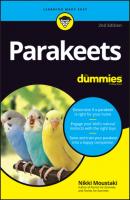Parakeets For Dummies. Nikki Moustaki
Чтение книги онлайн.

Читать онлайн книгу Parakeets For Dummies - Nikki Moustaki страница 6
Название: Parakeets For Dummies
Автор: Nikki Moustaki
Издательство: John Wiley & Sons Limited
Жанр: Биология
isbn: 9781119755302
isbn:
Size difference: The American parakeet is smaller, thinner, and more streamlined than its British counterpart. The English show budgie is stately looking, with a full, prominent chest and forehead. Its eyes are barely evident and its beak is tucked into the feathers of its face. It is 8½ to 9½ inches long, whereas the American is about 7 inches long.FIGURE 1-1: The English budgie (left, male) and American parakeets (right, female, male).
Temperament: The American parakeet is feistier than the English budgie and may be more active than its mellower cousin. Both birds are good companions. Whichever type you choose, you can tame the bird into a wonderful pal, or keep a pair to watch and add some liveliness to your home.
Lifespan: Lifespan is one of the primary differences between the parakeet and the budgie. The big English budgie lives about 7 to 8 years, and the American parakeet can live 14 years or more with the proper care.
The Anatomy of a Parakeet
Knowing your bird’s anatomy will help you describe a problem to an avian veterinarian if you ever have to do so. You can also speak like an expert with other hobbyists. Here are the primary parts of your parakeet (see Figure 1-2):
Crown: The crown is the top of the head.
Nares (nostrils): The nares are at the top of the beak.
Cere: The cere is the fleshy area above the beak that contains the nostrils. It becomes blue in mature male parakeets, and brown in breeding condition females. When parakeets are young, it’s white to light pink. The cere is a purplish-pink in males and a whitish-blue in females (when females are not in breeding condition).
Beak: The upper and lower mandibles (jaws) make up the parakeet’s beak. The parakeet is classified as a hookbill, meaning that the beak is shaped like a hook and is perfect for cracking seeds and breaking twigs.
Ear: Your parakeet has small flat holes for ears, and they’re covered by thin feathers that protect the ear. This is why you can’t see them unless your bird is wet.
Eyes: The parakeet’s eyes are on either side of its head so that its field of vision is about 300 degrees. By contrast, a human’s field of vision is about 120 degrees. This wider view of the world is because the parakeet is a prey animal and needs to be constantly on alert for predators. Parakeets, like many birds, have a third eyelid called a nictitating membrane, which is a thin, semitransparent lid that washes the eye like a squeegee and closes for protection.
Throat: The throat is just beneath the beak and extends to the breast.
Nape: The nape is the back of the neck.
Shoulder: The shoulder is at the top of the wing nearest the parakeet’s back.
Breast: The breast is just below the throat.
Foot: Everything that most of us think of as a bird’s leg is actually a bird’s foot. That’s why the “knee” appears to bend the wrong way — it’s actually the bird’s heel. The parakeet’s foot is zygodactyl, meaning it has two toes in front and two in back, perfect for grasping and climbing.
Vent: The vent is where your bird eliminates. In a human, this would be a combined anus and urethra. Birds’ urine is not separate from their droppings; urine is combined with the fecal portion of the dropping as a small wet outer ring.
Primary feathers: Parakeets have ten long primary wing feathers that aid in flight.
Secondary feathers: The secondary feathers on the wing occur after the primaries, closer to the body.
Rump: The rump is beneath the primary flight feathers on the parakeet’s lower back.
Mantle: The mantle is the back area between the shoulders of the parakeet.
Crop: The crop is a sac-like organ that’s kind of like a “first stomach.” It’s where the food goes immediately after being swallowed and is located at the top of the breast.
Syrinx: The syrinx is equivalent to vocal chords in humans. It allows parakeets to talk and vocalize when air is pushed through it.
FIGURE 1-2: All the parts of a healthy parakeet.
Chapter 2
Is a Parakeet Your Perfect Companion?
IN THIS CHAPTER
If you’re trying to decide whether to bring a parakeet into your home, you’ve come to the right chapter. Even if you already have a parakeet, this chapter has something for you too. Here you’ll figure out what to expect from a parakeet (from its bubbly personality to the dreaded messes it makes) and what your parakeet expects from you. I walk you through the challenges posed by children and companion animals (whether birds or cats or dogs). I also give you information on keeping more than one parakeet.
Knowing What to Expect from a Parakeet
As wonderful as they are, parakeets are still considered wild animals, just as are all companion parrots. Though parakeets are about as close as a bird comes to being domesticated (other than the canary), they still have their quirks. Knowing what to expect from your parakeet — from personality to lifespan — will make your relationship with your bird better and stronger.
A great personality
As with humans, each parakeet is an individual with its own individual personality. Some are sweet and affectionate, while others may always remain fearful or aggressive. What you receive from your parakeet depends a lot on what you put into it. In general, a kind, careful guardian can tame a parakeet into a loving companion.
If you buy two parakeets that look similar, you may worry that you’ll СКАЧАТЬ